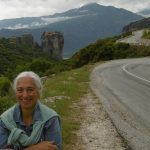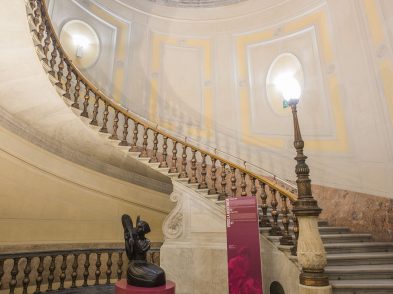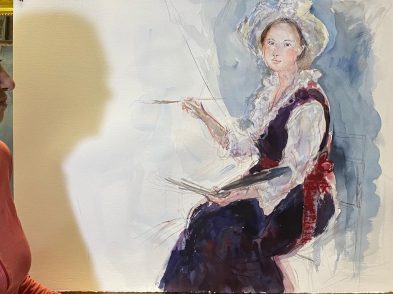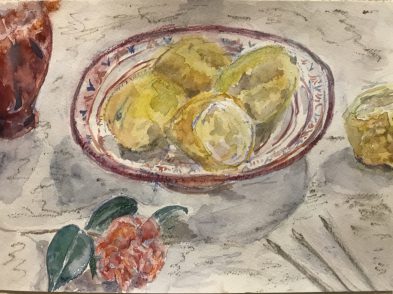It would be easy to miss the Marini museum, sandwiched as it is between two of Florence’s busiest and most elegant streets, Via della Vigna and Via della Spada (where shops such as Gucci, Roberto Cavalli, Dolce and Gabbana, Ferré are found). There is nothing to proclaim its presence in the de-consecrated church of San Pancrazio, one of the oldest in Florence, with foundations dating back to the 10th century. Its entrance is guarded by stone lions, there are massed cars and motorini to obstruct your approach and no queues of tourists to draw it to your attention. But that would be your loss, for once you cross the threshold, you enter a wonderful, airy, light-filled space, silent and far removed from the bustle of the city. It gives you a sense of being outside time, free to make the kind of discoveries about art and life that can make the world a better place. It’s there you can enjoy and meditate upon the work of a single artist, Marino Marini.
Marini, a Tuscan artist born in 1901, was trained as a painter but is known mainly as a sculptor, famous for his distinctive sculptures of horsemen in bronze and terracotta. At his death in 1980, he bequeathed a body of work to the city of Florence. His wife, Marina, added to this collection once she saw the space that would house the museum. A comprehensive presentation of his entire artistic output was thus donated, and currently includes prints, drawings, paintings and sculptures. Especially noteworthy is his collection of portrait busts and figures as well as the famous horsemen. For Marini, horses represented the instinctive life-force, and his first riders express a harmony and unity with the universe through their relationship with the horse. As the century progressed and war broke out, Marini’s horsemen began to reflect increased fragmentation and anguish as they try to hold on to the animal, but lose their balance. Another recurring figure in Marini’s work is that of Pomona, the goddess of agriculture. She is not represented as an idealised divinity, but, like all of Marini’s works, she expresses something earthly and human in her slightly ungainly imperfection. Pomona exudes the vitality and expressive quality of the ancient Etruscan sculptures the artist so deeply admired.
The building itself has been developed to highlight the nature of Marini’s work. The central axis of the former church is left open as one long gallery that covers the length of the building. Daylight enters through two huge semi-circular windows at either end, with views of Florence’s medieval roof tops. On either side of this central space, there are staircases that lead to the other levels and gangways that run around and across the building. These varying levels give unexpected glimpses of the sculptures from above and below. Different angles and distances give the viewer a new perspective each time they look at a piece.
Downstairs, the vaulted crypt houses temporary exhibitions by contemporary artists, an important initiative in a city that has limited public spaces for contemporary art. The museum allows for dialogue with the great works of the past as well as of more recent masters, such as Marini himself. A big challenge for any contemporary artist, this creative dialogue allows pieces from different perspectives and periods to be exhibited together. The contrast produced allows the visitor a worthwhile opportunity to reflect more fully on all the works in the museum.
The museum’s education service, which provides workshops for children and adults, also supports this objective. The museum’s current show, L’ora sospesa (‘Time suspended,’ open until Nov. 11), showcases paintings by Florentine artist Giovanni Paszkowski. The mixed media works of lone figures in blank urban landscapes are reminiscent of early Hockney and Edward Hopper in their graphic quality and subject matter, but without Hopper’s unsettling edge. A group of more recent works, Colloqui (‘Dialogues’), shows figures in museums or contemplating a single work by Moore, Giacometti, or Marini, in homage to these artists. The exhibition shows the loneliness and alienation of urban life in a claustrophobic world, but the anonymity of the figures keeps the viewer at a distance and fails to engage in the way that Marini’s work does.
It is a relief to go upstairs into the natural light of the main museum and to appreciate the tenderness, compassion and feeling for the human condition in Marini’s work. Looking once again at his horsemen, one sees their primal energy, the identification of man with nature in that state of innocence before the Fall. Elsewhere, the viewer perceives his anxiety, expressed through rougher and more fragmented shapes. The horseman raises his arms, not in ecstasy but in despair or as a cry for help looking up to where heaven should be. Marini’s works convey and arouse a whole range of human experiences and emotions: love, pity, tenderness, joy, fear, anger, horror, hope. Marini said, ‘It’s not important what you depict but how you express it.’ Ultimately, it is the solidity and sense of presence in his works that triumph over his restlessness and anxieties. This winning battle allows one to leave the museum feeling renewed and able to face life’s challenges.








